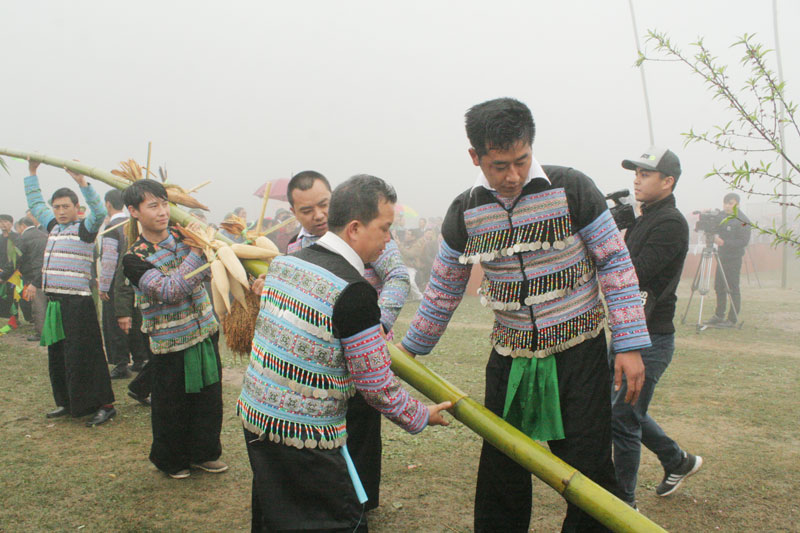
(HBO) - In the early spring, the weather was cold and mountains and forests in the northwest were covered by dim mist. We visited Hang Kia and Pa Co communes in the mountainous district of Mai Chau. Together with local people and tourists, we were immersed in the festive atmosphere of Gau Tao – a cultural symbol of the Mong ethnic group. In Mong ethnic language, Gau Tao means travelling to sacred mountain in spring to pray for blessings.

Neu tree planting ceremony - special ritual of Gau Tao festival
Neu tree during the Gau Tao festival bears the symbol of a sacred tree linking
heaven with earth, praying for the birth of children and bumper harvest. For
long when spring arrives, the Mong people often erect neu trees, considering it
a sacred symbol to avoid bad luck and bring good luck for the New Year.
According to the legend, neu tree is erected with the purpose of preventing
devils from the East Sea from entering the mainland. However, over time, the
meaning of planting neu trees during New Year and spring days has been further
spread.
During the festival, the tree is a highlight, connecting the public. Once neu
tree is erected, all activities stop, creating an absolute balance between the
old and new years. People have fun activities and ignore sorrows of the old
year. When the tree is erected, the shaman will do worship rituals under the
tree canopy to pray for good health, well-being and bumper harvest.
The Gao Tau festival has long been considered a cultural symbol of the Mong
ethnic people. It was added to the list of national intangible cultural
heritages in December 2012 by the Minister of Culture, Sports and Tourism. In
2017, for the first time, the provincial People's Committee decided to re-stage
Gau Tao festival. The Gau Tao festival of the Mong ethnic group in Pa Co
commune, Mai Chau district in 2017 was held at a stadium in Xa Linh hamlet, Pa
Co commune.
Mua A Ky from Xa Linh 1 village, Pa Co commune, over 60, was very excited to
join the festival. He said Gau Tao festival is a traditional cultural and
religious activity of the Mong people.
joining Gau Tao festival, visitors could join in a number of cultural, art and
sport activities such as Khen (pan-pipe) dancing performance in Pa Co and Hang
Kia communes. Traditional food and outstanding agro-forestry products imbued
with Mong ethnic characteristics were also introduced to visitors. Among
highlights were also the crafting of knifes and the making of traditional rice
cakes.
Following the success of Gau Tao festival 2017 in Pa Co commune, the event was
held in Hang Kia commune this year.
Gau Tao festival held in Pa Co and Hang Kia communes not only contribute to
preserving and upholding traditional cultural values of the Mong ethnic group
and popularising historic and cultural values, and typical tourist products of
Hoa Binh in general and Mai Chau district in particular./.
Hoa Binh province has carried out multiple programmes and initiatives to revive its cultural heritage which has gradually fallen into oblivion through the ebbs and flows of history.
The most prominent and defining feature in the prehistoric era of Hoa Binh is the Hoa Binh Culture. The Culture was first discovered in Hoa Binh. The significant prehistoric culture represents not only Vietnam but also Southeast Asia and southern China. Through excavations of cave sites in the limestone regions of Hoa Binh, French archaeologist M. Colani introduced the world to a "Stone Age in Hoa Binh province – Northern Vietnam" in 1927. On January 30, 1932, the First Congress of Far Eastern Prehistorians, held in Hanoi, officially recognised the Hoa Binh Culture.
Known as the "Land of Epic History”, Hoa Binh province, the gateway to Vietnam’s northwest, boasts a strategic location and a unique cultural tapestry woven by its ethnic minority communities.
The People's Committee of Luong Son District recently held a ceremony to receive the certificate recognizing Sau Communal House in Thanh Cao Commune as a provincial-level historical and cultural site.
Recognising the importance of cultural heritage preservation in protecting and promoting the value system of Vietnamese culture, and serving socio-economic development in the new period, Party committees and local administrations in Hoa Binh province have identified it as a key task in the cultural development strategy. The province has been making efforts in mobilising resources, creating consensus among people and engaging ethnic communities in preserving and promoting cultural identity.
Hoa Binh province has captured growing attention both domestically and internationally for its distinctive cultural heritage and rich history. Most notably, it has been renowned for its famous Hoa Binh culture, considered the cradle of ancient Vietnamese civilisation. Looking ahead to significant milestones in 2025 and the 140th anniversary of province establishment in 2026, Hoa Binh Newspaper presents a comprehensive overview of the province's development across economic, social, cultural, tourism, and security domains.



